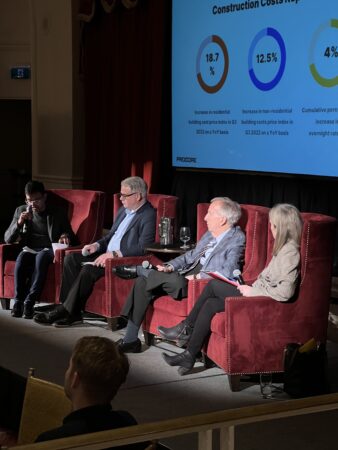
Daniel Reale-Chin
Modestly optimistic outlook for 2023
Canadian Contractor construction economic forecast Net ZeroLabour shortages, technology and the impact of net-zero policies remain hot topics as panel looks at Canadian construction forecast for 2023.

Harshil Gupta, Adam Freill, Alex Carrick and Mary Van Burren gave their insights for the construction industry in 2023.
It won’t surprise the panelists from Procore’s Canadian Construction Forecast 2023 if the construction sector outpaces the slowing growth expected in Canada’s general economy this year.
The panelists at the event, which took place at the Fairmont Royal York hotel in Toronto on January 31, outlined what their research is indicating as they discussed factors driving construction forward in Canada, as well as potential downside risks such as geopolitical and economic trends in 2023.
Harshil Gupta, regional product marketing manager for Procore, hosted the panel.
“This is a historically tight labour market,” said Gupta. He kicked off the discussion by saying that the Business development Bank of Canada (BDC) expects the Canadian gross domestic product (GDP) to grow by a modest 0.5 per cent in 2023. “They would like us to think of this as economic stagnation rather than recession,” he explained.
Mary Van Buren, president of the Canadian Construction Association cited her association’s own economic reporting for 2023, which expects a slowdown in the second quarter on the residential side of construction. Van Buren said that sentiment and optimism remains high in the industry, however, and stated that factors like decaying infrastructure in Canada and the push to “green” civil infrastructure and buildings across the country will create opportunity for the construction industry.
Immigration will also have a positive impact on high-rise residential construction, said Adam Freill, editor at On-Site magazine. Freill expects the increased number of newcomers to Canada in 2022 and 2023 to be a positive catalyst for the multi-unit residential segment of construction in the coming years.
Alex Carrick, chief economist at ConstructConnect, considered the geopolitical factors that will affect the industry, “I think the talk of recession is overblown,” said Carrick, “There was a 2.1 per cent increase in GDP in the U.S. in 2022 and the unemployment rates are low in both Canada and the U.S.”
Carrick stated that the global push toward Net-Zero 2050 is as important as the industrial revolution because the entire world is moving away from a dependence on fossil fuels. With this global push, Carrick says mega-construction projects have started in Canada and the U.S. as the countries look to build hydrogen plants, electric-vehicle manufacturing plants, chip-making plants and battery plants like the over $5 billion battery-manufacturing plant by Stellantis and LG Energy Solution in Windsor, Ont.
Among the factors that could have a negative impact on the industry were labour and supply chain shortages.
“Our contractors are feeling the pain of shortages. They’ve had to decline projects because of labour shortages and it’s impacting Canada’s ability to grow,” said Van Burren.
“Labour has always been in the top three issues impacting our industry,” said Freill, who added that technology like software to manage projects and paperwork can help mitigate some of the issues. “It’s about doing more with what we do have, and technology can help us do that.”
Each panelist mentioned the positive impact technology can have in the industry. Carrick expects automation to continue trending higher in the industry and suggested modular building and 3-D printing of components as advances that can help the industry. Van Burren mentioned that exoskeletons can also help mitigate the wear-and-tear on labourers’ bodies and can allow more types of people to enter construction.
Beyond technology, Van Burren put some of the ownness of solving the industry’s labour-shortage issue on the federal government: “We need to change the point system for immigration. We need to let in more skilled labourers.”
Looking ahead, Van Burren said she is looking forward to more predictability in the coming year. She would like to see a stabilizing workforce and GDP and expects the government to commit to long-term (25-year) infrastructure plans.
“Long-term, we have a good outlook in terms of infrastructure. I’m looking forward to seeing another year of growth,” said Freill.
Carrick took a geo-political approach in looking ahead. “Canada is poised to hit a population of 40 million in one year,” he said, citing the positive impact immigration should have on construction and building our cities. “Going forward, U.S. politics are going to be a key determining factor.”

Leave a Reply